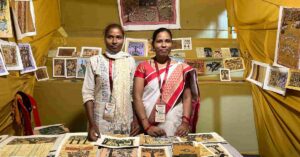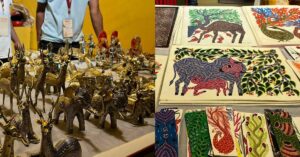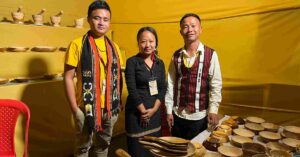TBI Travel: Purushwadi – Living the Tribal Life
Gangadharan Menon visits Purushwadi, a tribal village in Maharashtra, and discovers its many paradoxes while celebrating Holi with them. Experience with him the joys of living a tribal village life,

Gangadharan Menon visits Purushwadi, a tribal village in Maharashtra, and discovers its many paradoxes while celebrating Holi with them. Experience with him the joys of living a tribal village life, largely untouched by external influences, but where sadly things are changing as well, in a place governed by a female deity and yet called “Purush”wadi!
The presiding deity of this tribal village is a goddess called Zakubai. A goddess so powerful that she took it upon herself to protect this village and the nearby four villages, without any help from any of the male gods. She even went to the extent of decreeing that the idols of Hanuman be removed from these five villages. To this day, these five banished idols are kept on the banks of a river, near a village called Khadki, all with their faces down. If anyone ever attempts to make these idols stand upright, by the next day morning, the idols are found lying flat on their faces again!
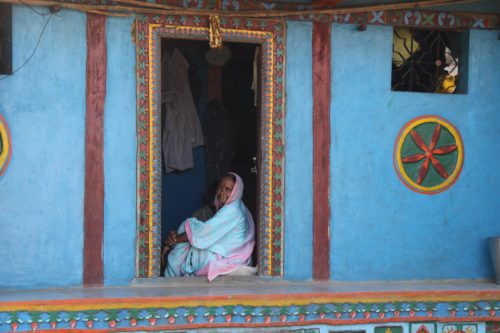
Though the village is matriarchal, and is ruled by a tribal goddess, paradoxically it is called Purushwadi. It is said that earlier it was called Pur-unch-wadi, which means the village on top of the mountains. With the gradual onslaught of a male-dominated society, it was conveniently changed to Purushwadi!
This tribal village is about 180 kms from Mumbai, beyond Igatpuri, situated in Ahmednagar district. It’s one of the villages adopted by Grassroutes, an organization that has been promoting village tourism in this tribal belt for over 4 years.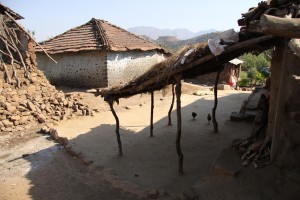
Today, Purushwadi is a picturesque village of 109 houses in which a tribal community called Mahadeo Kolis lives in perfect harmony with nature. Here again, there is a living paradox. In the very name of the tribe protected by a goddess, a mainstream god has crept in: Mahadeo or Lord Shiva. The fact that these tribals now trek to the Bhairavnath temple situated about 20 kms from here for blessings, points to the influence of a mainstream religion on tribal beliefs.
In 2006, only a handful of households joined the Village Tourism Committee. Today over 60 households welcome guests to stay with them and experience what it is to live in a village. To make sure that the guests don’t experience a culture shock, the housekeepers, the cooks and the guides have been extensively trained.
So the guests, whether they stay in the tents pitched in the wheat fields on the outskirts of the village, or in the houses in the village itself, can expect the basics: clean toilets, clean towels, safe water to drink, hot water to bathe, clean mattresses and bedsheets, and even a green salad along with the otherwise authentic, rustic food!
Our host was a lady called Jijabai, whose husband Punaji was the clerk of the Panchayat. All our meals were cooked and served in this matriarch’s house, including the morning tea. I thought the disarming, perpetual smile on her face was because we were her special guests. But as I stepped out of her house into the village, at every corner I saw the same smile on a hundred other faces. And I realized that Mahadeo Kolis are an extremely friendly and warm people. We walked through the narrow lanes of the village as if it was our own village. And the best part was they continued their regular activities, unmindful of our presence: whether they were filling water in their pots, or cutting wood, or harvesting in the wheat fields, or milking their cattle. It was a real slice of life, and not a show that was specially put up for us. Much like the Masais of Kenya who had got used to guests coming into their villages; and who lived out their life in the open, in front of a hundred inquisitive eyes.
It was at the village square that I meant Datta, an authority on the local flora and fauna. Apart from telling us about the various plants and trees endemic to the area, he also told us about the local varieties of wheat and paddy. And how the import of hybrid seeds into the village had already resulted in three of the endemic rice varieties becoming extinct. Despite the advent of mainstream agriculture, some local species survived. And whenever someone in the village falls ill, they ensure that only those local species of rice is cooked and served to the patient, till he or she is fully recovered!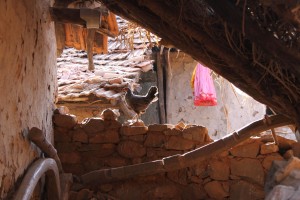
Datta also told us about the adverse impact of the scheme of afforestation. As part of this scheme, the tribals were asked to plant innumerable saplings on a barren hillock. The intentions were noble; but the saplings sadly were of eucalyptus, acacia and jatropa. All of which, when they spread from the hillocks into the unsuspecting farmlands, can create havoc with the local plant species, as they guzzle water and deplete the moisture in the soil, and even the ground water. A paradox that works against the laudable and extremely successful attempts at water conservation in this village by the world-renowned watershed management organization called WOTR. By digging trenches at various levels on all the adjoining mountains, this organization has managed to slow down the flowing rain water, so that the top soil is retained and more water is absorbed into the soil, thereby improving the ground water resources. The motto is simple: ‘If the water is running, make it jog; if the water is jogging, make it walk; if the water is walking; make it stop!’
Another interesting character we met was Atmaram, the local expert in honey collection. He is actually a shepherd who goes into the nearby jungles to graze his goats. And as they lazily graze on the grasslands, he follows the busybees to their honeycombs. Village folklore has it that once a tiger attacked his favourite goat, and he grappled with the predator till he secured his goat’s release.
Next up was our trek to the highest point in the region. And on our way to the top, we came across many sacred stones marked in saffron. Made of all shapes and sizes, they were the original idols of the adivasis. An insight into their beliefs was provided by our adivasi guide. When we asked him where the nearest village was, he answered, ‘There, right in the belly of that mountain.’ Showing that, for an adivasi, a stone is a living thing!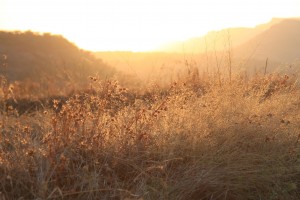
As the sun slowly started dipping behind the Western Ghats, the vast landscape of dried up grass on the hilltop became a gorgeous tapestry woven with endless golden threads. And when we started our descent, our weary path was lit up by the rising full moon, as it was the night of Holi.
In Purushwadi, everything begins at Zakubai’s temple. So did the Holi celebrations. The pyre of dried twigs and small branches was waiting in all readiness. After the temple lamp was lit, young girls lit up their own diyas from the flame of the lamp, and these were then used to light up the Holi pyre. Soon, aided by a strong breeze, gigantic tongues of fire leapt into the sky, as if to rival the rising moon.
The next day morning, we climbed down the mountain slopes lined with mango trees in full bloom, to reach the blue river. For a river of its ethereal beauty, it had a phonetically ungainly name: Kurkundi. A dip and a swim in the chilled blue waters did wonders to rejuvenate us and we walked briskly to the village for our breakfast. We had deliberately worn old clothes in anticipation of a colourful Holi ahead. But when we reached the village, there were no pichkaris, no colour-filled balloons, no bucketsful of vibgyor colours.
That’s when it dawned on my urban mind that Rang ‘Panchami’ is actually meant to be celebrated on the 5th day after the full moon. It’s the domination of the North Indian culture, perpetrated through Bollywood, that irrevocably changed it to the 2nd day!
Untouched by this, the tribals here were getting ready for five days of festivities packed with various rustic competitions. The first one was to lift one of the three perfectly round boulders that were kept at the village square. And the boulders weighed 25 kgs, 50 kgs, and one well over a 100 kgs! This was followed by Kabaddi matches, wrestling bouts, and you guessed it right, the mainstream sport: cricket!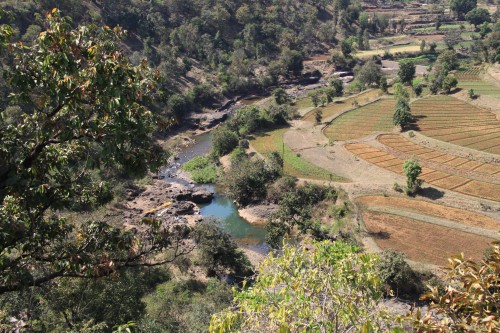
As we bid farewell to Jijabai and her family, I really wished this tribe retains its rustic innocence, and its very special beliefs and rituals. But the recently-constructed iron bridge that stretches across the river, connecting this tribal village to the mainland, is a grim reminder that mainstream thought will come in by that road, by the hour and by the day, and smother the special flavours that have evolved here over many, many centuries. Eventually resulting in the vanillisation of culture, where one flavour suits all.
How To Get There: Purushwadi is 185 kms from Mumbai. Take the Mumbai-Nashik road to Igatpuri, continue towards Ghoti, take the road to Rajur, and then turn towards Harischandra Gad. Purushwadi is 20 kms before Harischandra Gad.
For travelling and living in this village get in touch with grassroutes.co.in
All Photos: Gangadharan Menon
This story made me
- 97
- 121
- 89
- 167
Tell Us More
We bring stories straight from the heart of India, to inspire millions and create a wave of impact. Our positive movement is growing bigger everyday, and we would love for you to join it.
Please contribute whatever you can, every little penny helps our team in bringing you more stories that support dreams and spread hope.






